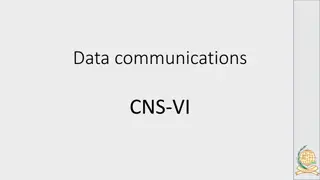
Interprocess Communication in Software Systems
Learn about how processes communicate within an application, the importance of IPC, the consequences of stack overflow, and the different types of interprocess communication methods used in software development.
Download Presentation

Please find below an Image/Link to download the presentation.
The content on the website is provided AS IS for your information and personal use only. It may not be sold, licensed, or shared on other websites without obtaining consent from the author. If you encounter any issues during the download, it is possible that the publisher has removed the file from their server.
You are allowed to download the files provided on this website for personal or commercial use, subject to the condition that they are used lawfully. All files are the property of their respective owners.
The content on the website is provided AS IS for your information and personal use only. It may not be sold, licensed, or shared on other websites without obtaining consent from the author.
E N D
Presentation Transcript
How do processes communicate? Within a process Shared data Internal function call Can be used in single threaded Can be used in multi-threaded (refer to OS slides) Between processes IPC (Interprocess communication)
Basic function calls WITHIN a process SomeFunction() { callMyFunction( param1, param2, param3) nextCommand } Stack Stack Stack Stack callMyFunction( int p1, float p2, double p3){ callMyFunction( param1, param2, param3) } param1 param2 param3 &callMyFunction &nextCommand Heap Heap Heap Heap Essentially: - Each param is pushed onto a stack (param1 then param2 then param3) - The programCounter (address) for the returning function is pushed - The program address for the function-to-be-called is pushed - The OS is told to jump to the address on the process stack Data Data Data Data Text Text Text Text
And so This is how communications works within a single application Given you have factored your code into multiple pieces (classes, functions, ) You can call each piece with a function call or something equivalent Application memory is used to keep track of data and addresses using Stack memory Question: What happens when you get a stack overflow? (Yeah, it s not just a place online to find code snippets) Too many parameters, callback/ return addresses Often from infinite loops, recursion
Multiple Processes This does NOT work? Why? Each process is in it s own address space The Data Stack is NOT shared The process addresses are not known from Application A to Application B. There is a failure to communicate! (Apologies to Cool Hand Luke) And so we need IPC
Why do processes need to communicate? Information sharing Computation speedup Modularity and protection Enable multitasking
Types of Interprocess Communication File system It is (really) an API i.e. a contract of how to communicate with/ between software Sockets But it is unstructured and untyped All manual documentation to define the interface Not compile time enforced Can have runtime error checks for format Example: Configuration files (think .ini files; think registry; think UNIX .rc or .cfg files) Example: Windows Message Queues (look it up) Pipes Shared memory Message Queues
Producer File Consumer File Simple Producer writes file, Consumer reads file Both parties must agree on a known location Need to account for Producer and Consumer both accessing the file at the same time. Consumer reading an incomplete file Deletion of file out from under Producer Need a semaphore to signal when a file is ready for consumption
Shared memory A global shared memory location is established Each process can read/ write to that location and communicate Similar to global variables, except outside the process memory space May need a semaphore to prevent reading and writing at the same time Examples: Printers PDL decomposed into bitmap in shared memory, printer consumes bitmap
Pipes Type of message queue Specifically between two processes (client/ server or peer-peer) Acts like a FIFO message list Push a message in, receiver pulls the message out Scan all open ports and list only occurrences of port 22:
Sockets Like a pipe, but uses network socket vs. global memory Local processes can also listen on a socket so this is still IPC Example: Localhost Specifics: When you run a webserver on your PC (for debug), the server is listening on Port 8001 (for example) for HTTP messages to process
Message Queues Like shared memory, but structured and with controls on send/ receive Global memory assigned for incoming messages Processes place a message in the queue Other process(es) read the message and remove from the queue as they use it Like a mailbox for software Examples: Windows Message Queues http://sqs-public-images.s3.amazonaws.com/Building_Scalabale_EC2_applications_with_SQS2.pdf
Deadlock A set of processes is in a deadlock state when every process in the set is waiting for an event that can only be caused by another process in the set. A deadlock situation can arise if and only if the following four conditions hold simultaneously in a system: 1. Mutual Exclusion: At least one resource is held in a non-sharable mode 2. Hold and Wait: There must be a process that is holding at least one resource and is waiting to acquire additional resources that are currently held by other processes 3. No Preemption: Resources cannot be preempted 4. Circular Wait: There must be a set {p0, p1, , pn} of waiting processes such that p0 is waiting for a resource which is held by p1, p1 is waiting for a resource held by pn and pn is waiting for a resource held by p0. Peterson, et al, Operating System Concepts, p.275-276
So now You have seen different ways to create an application, communicate between applications How do you know which mechanism to use? This will come down to requirements Reminder: ASR = Architecturally significant requirements Things that affect - How you decompose - How you communicate - How you have an efficient and reliable program






















